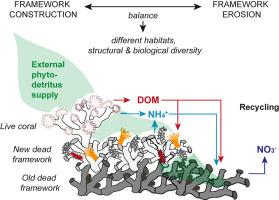Deep Sea Research Part I: Oceanographic Research Papers ( IF 2.4 ) Pub Date : 2021-06-08 , DOI: 10.1016/j.dsr.2021.103574 Sandra R. Maier , Furu Mienis , Evert de Froe , Karline Soetaert , Marc Lavaleye , Gerard Duineveld , Olivier Beauchard , Anna-Selma van der Kaaden , Boris P. Koch , Dick van Oevelen

|
Cold-water coral (CWC) reefs create hotspots of metabolic activity in the deep sea, in spite of the limited supply of fresh organic matter from the ocean surface (i.e. phytodetritus). We propose that ‘dead’ coral framework, which harbours diverse faunal and microbial communities, boosts the metabolic activity of the reefs, through enhanced resource retention and recycling. Analysis of a video transect across a 700-540 m-deep CWC mound (Rockall Bank, North-East Atlantic) revealed a high benthic cover of dead framework (64%). Box-cored fragments of dead framework were incubated on-board and showed oxygen consumption rates of 0.078–0.182 μmol O2 (mmol organic carbon, i.e. OC)−1 h−1, indicating a substantial contribution to the total metabolic activity of the CWC reef. During the incubations, it was shown that the framework degradation stage influences nitrogen (re)cycling, corresponding to differences in community composition. New (less-degraded) framework released ammonium (0.005 ± 0.001 μmol NH4+ (mmol OC)−1 h−1), probably due to the activity of ammonotelic macrofauna. In contrast, old (more-degraded) framework released nitrate (0.015 ± 0.008 μmol NO3− (mmol OC)−1 h−1), indicating that nitrifying microorganisms recycled fauna-excreted ammonium to nitrate. Furthermore, the framework community removed natural dissolved organic matter (DOM) from the incubation water (0.005–0.122 μmol C (mmol OC)−1 h−1). Additional feeding experiments showed that all functional groups and macrofauna taxa of the framework community incorporated 13C-enriched (‘labelled’) DOM, indicating widespread DOM uptake and recycling. Finally, the framework effectively retained 13C-enriched phytodetritus, (a) by physical retention on the biofilm-covered surface and (b) by biological filtration through suspension-feeding fauna. We therefore suggest that the dead framework acts as a ‘filtration-recycling factory’ that enhances the metabolic activity of CWC reefs. The exposed framework, however, is particularly vulnerable to ocean acidification, jeopardizing this important aspect of CWC reef functioning.
中文翻译:

与“死”冷水珊瑚框架相关的珊瑚礁群落推动了深海资源的保留和回收
尽管来自海洋表面的新鲜有机物质(即植物碎屑)供应有限,但冷水珊瑚 (CWC) 珊瑚礁在深海中创造了代谢活动的热点。我们建议“死”珊瑚框架拥有多种动物群和微生物群落,通过增强资源保留和回收来促进珊瑚礁的代谢活动。对 700-540 米深的 CWC 土墩(Rockall Bank,东北大西洋)的视频横断面的分析显示,死框架的底栖覆盖率很高(64%)。死框架的盒芯碎片在机上孵育,氧消耗率为 0.078–0.182 μmol O 2 (mmol 有机碳,即 OC) -1 h -1,表明对 CWC 珊瑚礁的总代谢活动有重大贡献。在孵化过程中,表明框架降解阶段影响氮(再)循环,对应于群落组成的差异。新的(较少降解的)框架释放了铵(0.005 ± 0.001 μmol NH 4 + (mmol OC) -1 h -1),这可能是由于大型动物群的活动。相反,旧的(更降解的)框架释放硝酸盐 (0.015 ± 0.008 μmol NO 3 − (mmol OC) −1 h −1),表明硝化微生物将动物群排泄的铵回收为硝酸盐。此外,框架群落从孵化水中去除天然溶解有机物(DOM)(0.005-0.122 μmol C (mmol OC) -1 h -1)。额外的饲养实验表明,框架群落的所有功能组和大型动物分类群都包含13 C 富集(“标记”)DOM,表明 DOM 被广泛吸收和回收。最后,该框架有效地保留了13富含 C 的植物碎屑,(a) 通过在生物膜覆盖的表面上的物理保留和 (b) 通过悬浮喂养动物群的生物过滤。因此,我们建议死框架充当“过滤回收工厂”,增强 CWC 珊瑚礁的代谢活动。然而,暴露的框架特别容易受到海洋酸化的影响,危及 CWC 珊瑚礁功能的这一重要方面。


























 京公网安备 11010802027423号
京公网安备 11010802027423号